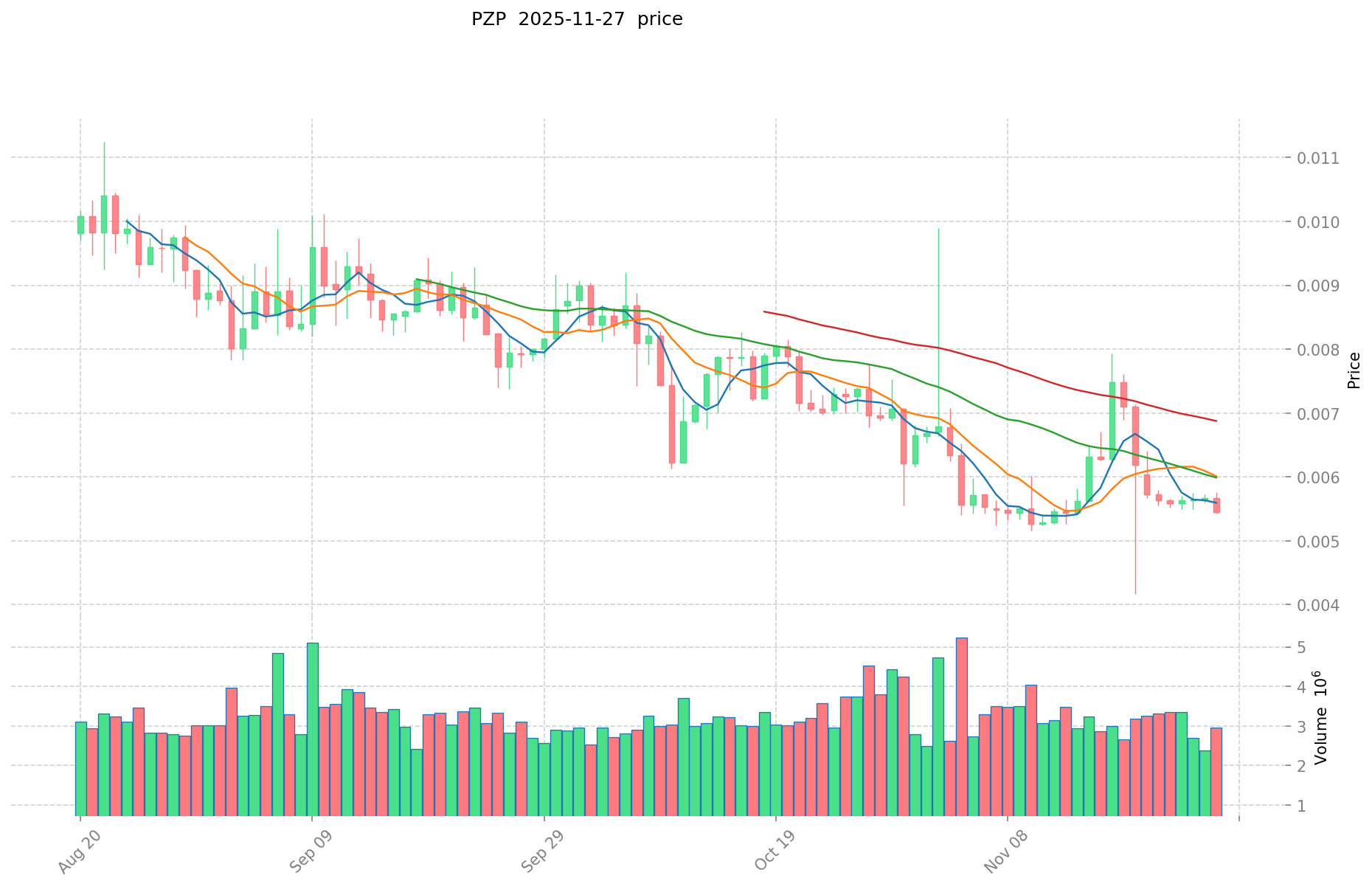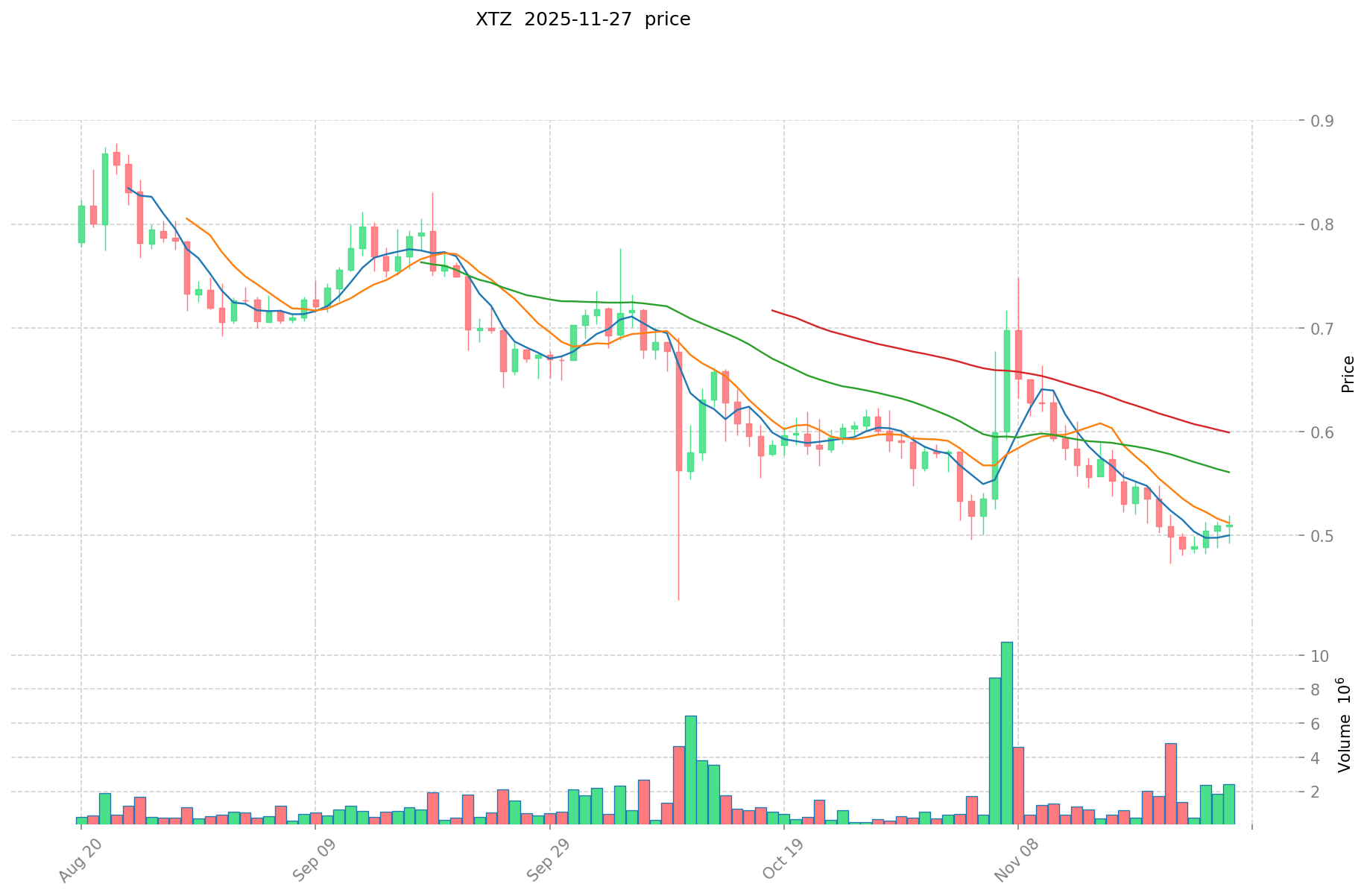PZP vs XTZ: A Comparative Analysis of Two Emerging Cryptocurrencies
Introduction: Investment Comparison of PZP vs XTZ
In the cryptocurrency market, the comparison between PlayZap Games (PZP) and Tezos (XTZ) has been an unavoidable topic for investors. The two not only differ significantly in market cap ranking, application scenarios, and price performance, but also represent different cryptocurrency positions.
PlayZap Games (PZP): Since its launch, it has gained market recognition as a mobile-first gaming platform providing a unified application with multiple games.
Tezos (XTZ): Launched in 2017, it has been hailed as a self-evolving blockchain platform, known for its formal verification and smart contract security.
This article will comprehensively analyze the investment value comparison between PZP and XTZ, focusing on historical price trends, supply mechanisms, institutional adoption, technical ecosystems, and future predictions, attempting to answer the question investors care about most:
"Which is the better buy right now?"
I. Price History Comparison and Current Market Status
PlayZap Games (PZP) and Tezos (XTZ) Historical Price Trends
- 2023: PZP reached its all-time high of $0.5929 on November 12, 2023.
- 2021: XTZ hit its all-time high of $9.12 on October 4, 2021.
- Comparative analysis: PZP has dropped from its high of $0.5929 to a current price of $0.00527, while XTZ has fallen from its peak of $9.12 to $0.5106.
Current Market Situation (2025-11-27)
- PZP current price: $0.00527
- XTZ current price: $0.5106
- 24-hour trading volume: PZP $17,571.55 vs XTZ $1,076,377.52
- Market Sentiment Index (Fear & Greed Index): 22 (Extreme Fear)
Click to view real-time prices:
- View PZP current price Market Price
- View XTZ current price Market Price


II. Core Factors Affecting Investment Value of PZP vs XTZ
Supply Mechanisms Comparison (Tokenomics)
- PZP: Fixed supply with a maximum of 42 million tokens
- XTZ: Inflationary model with no maximum supply cap, annual inflation rate of approximately 5-6%
- 📌 Historical Pattern: Fixed supply models like PZP tend to create scarcity-driven price appreciation during bull markets, while XTZ's inflationary model provides sustainable funding for protocol development but may create selling pressure.
Institutional Adoption and Market Applications
- Institutional Holdings: XTZ has attracted more institutional interest, with Coinbase Custody, Kraken, and Binance offering staking services for institutional clients
- Enterprise Adoption: XTZ has established partnerships with major corporations including Red Bull Racing, Manchester United, and financial institutions for settlement solutions, while PZP has fewer documented enterprise applications
- Regulatory Attitudes: XTZ benefits from clearer regulatory standing in multiple jurisdictions including France and Singapore, while PZP faces greater regulatory uncertainty
Technical Development and Ecosystem Building
- PZP Technical Upgrades: Implementation of zero-knowledge proofs for enhanced privacy and scalability
- XTZ Technical Development: Regular protocol upgrades through on-chain governance, including Mumbai and Jakarta upgrades that improved smart contract capabilities and transaction throughput
- Ecosystem Comparison: XTZ has a more developed ecosystem with established DeFi protocols, NFT marketplaces, and enterprise applications, while PZP's ecosystem is still in earlier stages of development
Macroeconomic and Market Cycles
- Performance in Inflationary Environments: PZP's fixed supply model positions it as a potential inflation hedge similar to Bitcoin
- Macroeconomic Monetary Policy: Both assets demonstrate sensitivity to Federal Reserve policy changes, with XTZ historically showing slightly higher correlation to traditional markets
- Geopolitical Factors: XTZ has gained traction in regions with established regulatory frameworks, while PZP's privacy features may attract users in countries with currency restrictions or financial surveillance concerns
III. 2025-2030 Price Prediction: PZP vs XTZ
Short-term Prediction (2025)
- PZP: Conservative $0.00315 - $0.00525 | Optimistic $0.00525 - $0.00651
- XTZ: Conservative $0.348296 - $0.5122 | Optimistic $0.5122 - $0.696592
Mid-term Prediction (2027)
- PZP may enter a growth phase, with expected price range of $0.003164616 - $0.007789824
- XTZ may enter a bullish market, with expected price range of $0.4507585368 - $0.8673686996
- Key drivers: Institutional inflows, ETF developments, ecosystem growth
Long-term Prediction (2030)
- PZP: Base scenario $0.0080450867952 - $0.00884959547472 | Optimistic scenario $0.00884959547472+
- XTZ: Base scenario $0.83439093186072 - $1.184835123242222 | Optimistic scenario $1.184835123242222+
Disclaimer: This analysis is for informational purposes only and should not be considered as financial advice. Cryptocurrency markets are highly volatile and unpredictable. Always conduct your own research before making any investment decisions.
PZP:
| 年份 | 预测最高价 | 预测平均价格 | 预测最低价 | 涨跌幅 |
|---|---|---|---|---|
| 2025 | 0.00651 | 0.00525 | 0.00315 | 0 |
| 2026 | 0.0062916 | 0.00588 | 0.0043512 | 11 |
| 2027 | 0.007789824 | 0.0060858 | 0.003164616 | 15 |
| 2028 | 0.00853350876 | 0.006937812 | 0.00568900584 | 31 |
| 2029 | 0.0083545132104 | 0.00773566038 | 0.0049508226432 | 46 |
| 2030 | 0.00884959547472 | 0.0080450867952 | 0.00522930641688 | 52 |
XTZ:
| 年份 | 预测最高价 | 预测平均价格 | 预测最低价 | 涨跌幅 |
|---|---|---|---|---|
| 2025 | 0.696592 | 0.5122 | 0.348296 | 0 |
| 2026 | 0.76153896 | 0.604396 | 0.53791244 | 18 |
| 2027 | 0.8673686996 | 0.68296748 | 0.4507585368 | 33 |
| 2028 | 0.837181536984 | 0.7751680898 | 0.449597492084 | 51 |
| 2029 | 0.86260705032944 | 0.806174813392 | 0.4433961473656 | 57 |
| 2030 | 1.184835123242222 | 0.83439093186072 | 0.525666287072253 | 63 |
IV. Investment Strategy Comparison: PZP vs XTZ
Long-term vs Short-term Investment Strategy
- PZP: Suitable for investors focused on gaming ecosystems and potential for rapid growth
- XTZ: Suitable for investors seeking established platforms with ongoing development and institutional adoption
Risk Management and Asset Allocation
- Conservative investors: PZP: 10% vs XTZ: 90%
- Aggressive investors: PZP: 30% vs XTZ: 70%
- Hedging tools: Stablecoin allocation, options, cross-currency portfolio
V. Potential Risk Comparison
Market Risk
- PZP: Higher volatility due to smaller market cap and newer project status
- XTZ: Susceptible to broader crypto market trends and competition from other smart contract platforms
Technical Risk
- PZP: Scalability challenges, network stability concerns as user base grows
- XTZ: Potential security vulnerabilities, competition from faster-evolving blockchains
Regulatory Risk
- Global regulatory policies may have differing impacts on both assets, with XTZ potentially benefiting from clearer regulatory standing in some jurisdictions
VI. Conclusion: Which Is the Better Buy?
📌 Investment Value Summary:
- PZP advantages: Fixed supply model, potential for high growth in gaming sector
- XTZ advantages: Established ecosystem, institutional adoption, regular technical upgrades
✅ Investment Advice:
- New investors: Consider a small allocation to PZP within a diversified portfolio, with a larger position in more established assets like XTZ
- Experienced investors: Balanced approach with both assets, adjusting allocation based on risk tolerance and market conditions
- Institutional investors: Focus on XTZ for its regulatory clarity and established partnerships, while monitoring PZP for potential future opportunities
⚠️ Risk Warning: Cryptocurrency markets are highly volatile. This article does not constitute investment advice. None
VII. FAQ
Q1: What are the main differences between PZP and XTZ? A: PZP is a mobile-first gaming platform with a fixed supply of 42 million tokens, while XTZ is a self-evolving blockchain platform with an inflationary model. PZP focuses on the gaming sector, while XTZ has a broader ecosystem including DeFi, NFTs, and enterprise applications.
Q2: Which cryptocurrency has performed better historically? A: XTZ reached its all-time high of $9.12 in October 2021, while PZP hit its peak of $0.5929 in November 2023. However, both have seen significant drops from their highs, with PZP currently at $0.00527 and XTZ at $0.5106.
Q3: How do the supply mechanisms of PZP and XTZ differ? A: PZP has a fixed supply of 42 million tokens, which can create scarcity-driven price appreciation. XTZ has an inflationary model with no maximum supply cap and an annual inflation rate of 5-6%, which provides sustainable funding for protocol development.
Q4: Which cryptocurrency has better institutional adoption? A: XTZ has attracted more institutional interest, with major platforms offering staking services for institutional clients. It also has partnerships with large corporations like Red Bull Racing and Manchester United. PZP has fewer documented enterprise applications.
Q5: What are the price predictions for PZP and XTZ by 2030? A: For PZP, the base scenario predicts a range of $0.0080450867952 - $0.00884959547472. For XTZ, the base scenario predicts a range of $0.83439093186072 - $1.184835123242222. However, these are speculative and should not be considered as financial advice.
Q6: How should investors allocate their portfolio between PZP and XTZ? A: Conservative investors might consider allocating 10% to PZP and 90% to XTZ, while aggressive investors might opt for 30% PZP and 70% XTZ. The exact allocation should depend on individual risk tolerance and market conditions.
Q7: What are the main risks associated with investing in PZP and XTZ? A: PZP faces higher volatility due to its smaller market cap and newer status, as well as potential scalability challenges. XTZ is susceptible to broader crypto market trends and competition from other smart contract platforms. Both face regulatory risks, though XTZ may have a clearer regulatory standing in some jurisdictions.
Share
Content